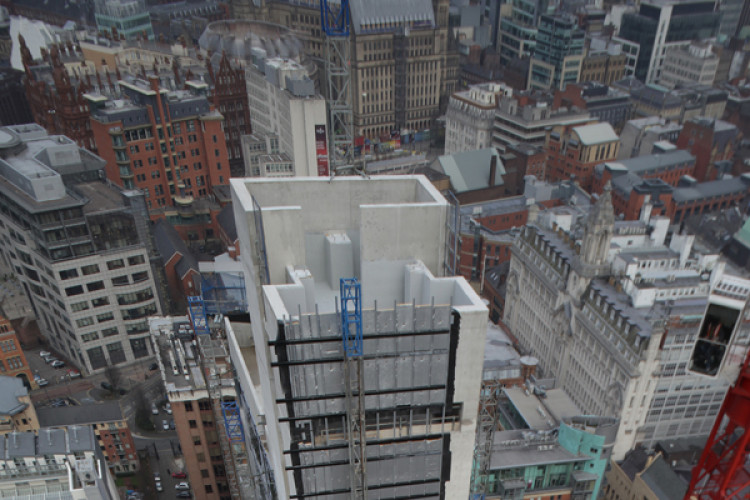Due for completion later this year, Manchester’s newest skyscraper is set to become the fourth tallest building in the city and will provide students with hi-tech contemporary living accommodation as well as jaw dropping views.
The £28.5 million project is being delivered by national contractor Shepherd Construction on behalf of developer Student Castle and is located within minutes of both the University of Manchester and the Manchester Metropolitan University on Great Marlborough Street.
The 11,000 net sq metre building, which is set to be a landmark in the city and will signpost the Oxford Road train station, sits upon a podium that addresses the sharp corner between New Wakefield Street and the adjoining Great Marlborough Street.
Above the podium the structure divides into a cluster of four towers that are staggered in height to relate more closely with the city’s surroundings. The south east tower corresponds to the height of some of the nearby developments including the ‘Green Building’ on Great Marlborough Street, while the south west tower relates to the height of the Waterhouse’s Refuge Building’s tower on Oxford Road. The north east and north west towers are taller, presenting a slender profile that will have a wider city presence.
Over 100m high
The 106-metre high structure comprises a concrete frame and envelope with curtain walling and a staggered pattern of four subtly-varying shades of blue grey terracotta cladding. The highest tower will have a wrap-around core at the top comprising silver Alucobond cladding.
Clive Williamson, construction director for Shepherd Construction, explains the contractor's decision to opt for concrete on the project.
“A concrete frame was specified as it provides a flat soffit,” he says. “In this situation there is no need for any downstand beams, enabling a reduced floor-to-floor height to be achieved which in-turn reduces the height and quantity of cladding required.
“The frame also provides more stability, especially when constructing high rise buildings, and also assists the construction programme by removing the need for return visits to each floor.”
Williamson feels that if a steel frame had been specified, it would have required the floor to be cast, and the steel to be fire protected and then acoustically sealed.
“A concrete frame requires no additional applied fire protection and offers greater acoustic performance than a steel frame solution,” he adds. “It is also much more difficult to accommodate the shear forces with a steel frame.”
Tight footprint
Before work began in August 2010 the project team had to get to grips with the challenges that the site presented, particularly delivering the high rise tower within an extremely tight footprint, and the site’s close proximity to the Oxford Road Station.
.png)
“Our project team adopted a ‘just in time’ approach for deliveries and organised local off-site storage for materials and manufacture of PPC columns,” explains Williamson.
A climb track system has been used for the central core. The tower crane now stands at its highest point of 99 metres. In order to gain this height, the crane has been extended from its initial free-standing height of 54 metres then up to 72 metres by self -climbing.
Due to the proximity of the railway, Shepherd also worked closely with Network Rail to ensure the safety conditions were met, including restricting the crane’s lifting capacity to 75%.
Logistical benefits
Concrete provided essential logistical benefits for the site team, according to Williamson.
“Using precast two-storey columns, the lifting requirements and crane time were both reduced – one lift for the pre-cast option compared with what would otherwise have been 16 lifts in-situ,” he explains. “The use of PPC columns offers another advantage by reducing the requirement for on-site storage of reinforcement and other material.”
The use of concrete has also produced significant cost savings.
Each of the 37 storeys is formed from post-tensioned slabs and two-storey precast columns. The post-tensioned slabs are thinner, mainly 200mm deep, apart from in one corner of each floor plate where they are 250mm deep to cater for the 3.2m cantilever.
“This has allowed the overall height of the building to be reduced by 2.7m and allowed less rebar to be used, which has produced cost savings of £235,000,” says Williamson.
The building is targeted to achieve a Very Good BREEAM rating, aided by the thermal massing and sound insulation properties of concrete.
The project is scheduled for completion in September 2012.
Project details:
- Client: Student Castle
- Main contractor: Shepherd Construction
- Architect: Hodder + Partners
- Structural Engineer: WSP
- Frame contractor: Heyrod Construction
- Post-tensioning contractor: Freyssinet
Concrete used
- Frame: 7,000m3
- Suspended slabs: 14,000m2
- Envelope: 9,000m2
Got a story? Email news@theconstructionindex.co.uk



